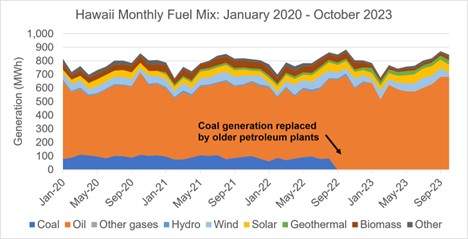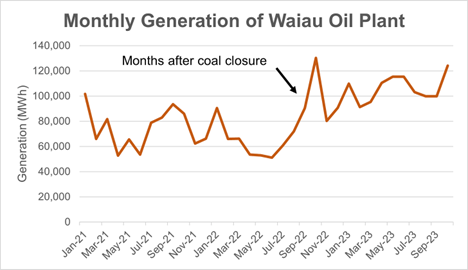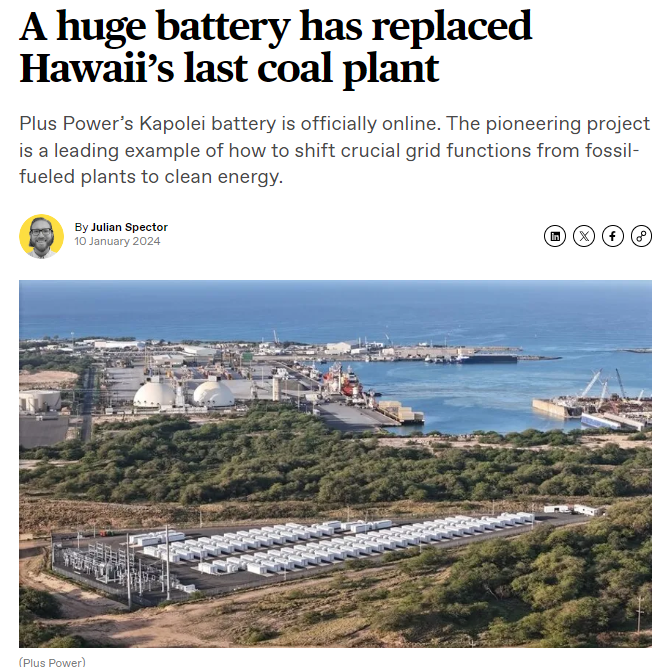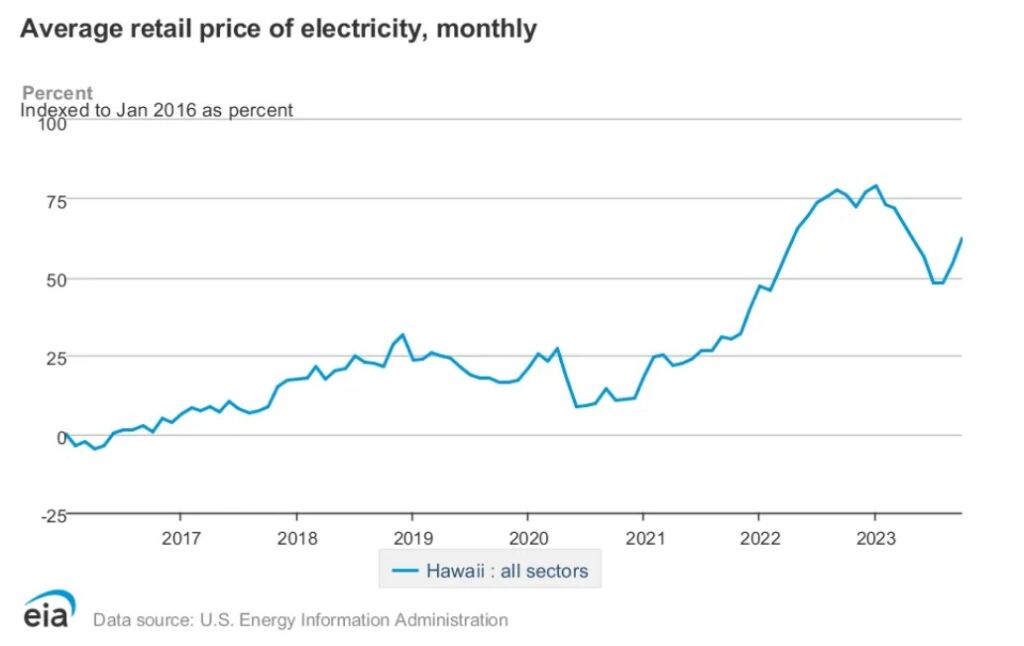Hawaii Five Uh-Oh! Blackouts in Hawaii
On January 8, 2024, a confluence of factors forced the Hawaiian Electric Company (HECO) to initiate rolling blackouts that affected about 120,000 electricity customers in two dozen communities on the island of Oahu, Hawaii.
The blackouts, which lasted from about 7:50 pm until 10:30 pm, were caused by a multitude of factors that we can put into two main categories: the immediate factors that caused blackouts and the long-term factors that made Oahu’s electric grid more vulnerable to blackouts in the first place.
Long story short, the state’s so-called “energy transition” set up the dominos for the power outages, ushering in the first rolling blackouts of 2024.
Book it, Danno!
What Caused the Blackouts? Immediate Causes: Heavy Rain
The most immediate cause of the blackouts was a Kona storm that brought heavy rain and strong winds from the south.
Email exchanges with HECO representatives revealed that the heavy rains caused one of the eight power-generating units at the Waiau oil-fired power plant to trip offline after rainwater got into a control system. Another unit tripped as the plant lost its transmission line to the grid, likely due to damage by the weather, knocking out 100 megawatts (MW) of capacity at the 500 MW facility.
The loss of these plants was significant because a number of other units were not in service due to scheduled maintenance, according to our emails with HECO. Electricity consumption is usually lower than average in December, which normally makes it a good time to make repairs at existing thermal stations.
At the same time, heavy rain and cloud coverage across the island limited solar generation. This lack of solar power meant the large batteries, which were supposed to replace the power lost by the closure of a coal plant on the island, were not charged to full capacity.
HECO stated that the large, 185 MW/565 megawatt-hour (MWh) Kapolei battery that accounts for 17 percent of Oahu’s peak capacity was 80 percent charged in the morning of January 8th, but it had been discharged due to the lack of solar and wind and drained even more with the loss of the thermal units later in the afternoon. By evening, the three-hour battery had run out of juice.
Adding insult to injury, wind generation declined just as it was needed most, and output from a garbage-burning facility was reduced, also likely due to weather.
The results were rolling blackouts.
What Caused the Blackouts? Long-Term Causes: Misguided Energy Policy
While a rainstorm and unfortunate timing constituted the short-term causes of the outages, the long-term causes of the blackouts stem from Hawaii’s unrealistic energy policies that have made the state’s electricity less reliable and more expensive.
In 2015, the state became the first in the nation to pass a law mandating an “energy transition” to 100 percent renewable energy by 2045. In 2016, Hawaii rejected a proposed liquefied natural gas (LNG) import and regasification facility, preferring to indulge in the fantasy that the state could “jump straight to renewables.”
The Hawaiian legislature’s misguided belief that the island state could move beyond fossil fuels to wind, solar, and battery storage was the driving force behind a 2020 law that banned the use of coal for electricity generation after December 31, 2022, effectively mandating the closure of a 180 MW coal plant owned by AES, the only coal facility in the state.
Hawaii stuck to these inadvisable commitments despite not building enough new wind, solar, and battery capacity to replace its retiring coal plant. As a result, when the AES Hawaii coal-fired power plant officially retired, it wasn’t a slew of new renewables that took its place. It was existing oil.
The Folly of Coal for Oil
The closure of the AES coal plant was energy malpractice for several reasons. Chief among them was the fact that the coal plant was only 30 years old with decades of useful life remaining to generate reliable electricity at a lower cost than the oil plants used to generate the majority of Hawaii’s electricity.
As Jim Kelly, Vice President of HECO, noted in 2022, “There is a cost associated to not burning coal.” For residents of Oahu, Hawaii, these costs represented more than higher bills – it also meant more reliability risks.
Reliability risks stemming from coal closure
The Energy Office describes Hawaii as one of the only states in the nation to retire a large fossil fuel unit, the AES coal plant, without transitioning first to another “bridge” fossil fuel like natural gas.
Hawaii’s inability to build enough new wind, solar, and battery facilities meant that oil facilities did the heavy lifting to replace the electricity generated from the prematurely retired coal facility, which you can see in the graph below using data from the U.S. Energy Information Administration.

In Oahu, the Waiau oil-fired power plant, in particular, became an increasingly crucial energy source once the coal plant was gone. Data from EIA show a significant uptick in generation at the plant after the closure of the AES coal facility.

The closure of the coal plant, which once supplied around 15 percent of peak electricity use on Oahu, meant there was less reserve generating capacity available to step into action when two units at the Waiau plant went down earlier this week.
This explains why, in the face of flatlining renewable generation and completely discharged batteries, the loss of these oil-fired units was enough to result in rolling blackouts.
Without coal, oil was virtually the only source of firm, reliable capacity on the island of Oahu because batteries only work if they’re charged. This decidedly-not-rocket-science reality makes the claims that batteries can replace the coal plant made by Canary Media all the more laughable.

While we believe having the coal plant online could have helped prevent the blackouts, we can’t know this for sure because HECO did not respond to our question asking how large the capacity shortfall was. It is also possible that the coal plant could have been on planned outage during the storm.
All we know is that an operational coal plant would have been much more helpful than a fully discharged battery, non-producing wind turbines, and cloud-covered solar panels.
Cost increases
The increased reliance on oil also came at an enormous cost to Hawaii families and businesses because it is much more expensive to generate electricity using oil than coal.
According to filings with the Federal Energy Regulatory Commission (FERC) showed the coal plant provided electricity to HECO for $123 per megawatt-hour (MWh) in 2022, while the Waiau steam and combustion turbine plants cost $299 per MWh and $398 per MWh.
This massive gulf in costs led Hawaii State Senator Glenn Wakai (D) to tell Canary media that the shutdown of the AES coal plant was “a monumental mistake by lawmakers” in light of how rates went up, as shown in the graph below from EIA.

Wind and Solar Projects Got Canceled
Hawaii policymakers had grand visions of a renewable future that was enshrined in law. However, efforts to make these dreams a reality by building the required wind and solar additions in the state have been derailed.
Several solar and battery projects have been canceled due to supply chain setbacks, rising costs, and tariffs on Chinese solar panels for allegations of unfair business practices and slavery. According to the Honolulu Star Advisor:
“December [2023] also was supposed to be when a 120-megawatt solar farm with 420 megawatt-hours of storage called Mahi Solar was projected to come online in Kunia. But this project, with a capacity to power about 37,000 homes, got canceled after delays.
Another Oahu solar farm project, Kupehau Solar, that was half as big as Mahi Solar [210 MW] and once expected to begin operating in 2023, also got canceled.
Two other solar farms with battery systems had been previously expected to go into service on Oahu in 2023 but have been delayed to later this year. One is Hoohana Solar, with 52 megawatts of generation capacity and 208 megawatt-hours of battery storage. The other is Waiawa Phase 2 Solar, with 30 megawatts of generation capacity and 240 megawatt-hours of battery storage.”
While these projects may have helped keep the lights on, we can’t know that for sure because these solar facilities, like the ones already on the island, would have been affected by the same weather patterns. This is why attempting to be carbon-free using wind, solar, and battery storage instead of nuclear power will always be gambling with the reliability of the grid.
Conclusion
The blackouts on January 8 should be a humbling experience for the lawmakers who brazenly tried to mandate an all-renewable grid and downplayed the reliability challenges brought on by the “energy transition.”
This sentiment was highlighted perfectly by a Khon News headline from 2022, “Power expected to be reliable but pricey, after coal-plant shutdown.” Unfortunately for residents of Oahu, this wasn’t the case.
Instead of passing legislation to force the coal plant to shut down, Hawaiian lawmakers should have let it continue generating relatively cheap electricity until they had built enough new power plant capacity, preferably nuclear, to properly replace it. This is a lesson lawmakers throughout the country should learn, but we’re not holding our breath.